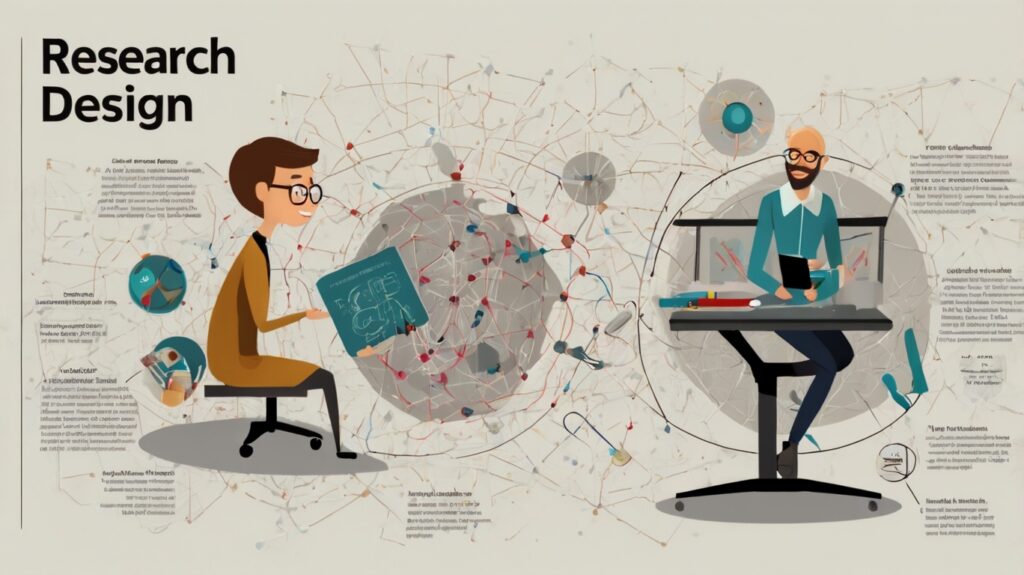Research Design
Research design refers to the planned, systematic, and structured approach employed to investigate research questions and achieve accurate results. A plan refers to the comprehensive framework or program of the investigation. It includes a comprehensive plan outlining the investigator’s actions, starting with formulating hypotheses and their practical consequences, and their definitive implication of data analysis.
A research design refers to the systematic organization of circumstances that are used to collect and analyze data in a way that effectively combines relevance to the study objective with efficiency in the process.
- Vimal Shah: Research design is the plan of study, whether controlled as well as uncontrolled and subjective as well as objective.
- Kerlinger: Research design refers to the systematic plan, structure, and technique employed to investigate research problems and control variability.
Types of Research Design
There are different types of research designs depending on the purpose of the study, the nature of the problem, and the objectives of the study. According to the purpose of the study, researchers usually adopt four types of research designs.
According to Purpose
Explanatory Research Design
In the explanatory inquiry, the researcher uses his own imagination and judgment to obtain information on the type of thing. In this type of research, the development of a hypothesis is not necessary. This study design involves the exploration of thoughts and ideas related to a certain issue in order to further investigate various hypotheses.
The primary objective of the research is to investigate the unexplored aspects of the subjects and provide answers to questions on their nature, methodology, and causes.
Descriptive Research Design

In this design, the researcher is interested in describing a situation or phenomenon under study. The data collected are mostly qualitative, e.g., attitude, behavior, public opinion, political interest, and so on.
This study design use data gathering methods such as natural observation, case studies, and questionnaires to get findings. This study design offers valuable understanding into the underlying reasons and methods employed in research.
Diagnostic Research Design
In diagnostic research, the design aims to investigate the underlying cause of a problem and provide effective methods to resolve it. This study methodology employs an organized approach to address problems, which is separated into three distinct phases: identifying the origin of the issue, diagnosing the issue, and proposing a remedy.
It is a problem-solving research method that consists of data collected through interviews, observations, and informal and formal testing.
- Emergence of a problem.
- Diagnosis of its causes.
- Formulating remedial measures.
- Suggestions for a solution.
Correlational Design
Correlational research design is used to establish a connection between two variables that are connected to each other. The researcher conducts longitudinal observations of the variables and thereafter formulates conclusions based on the gathered data. This study design requires the inclusion of two distinct groups.
Types of Study Designs in Quantitative Research
According to Contact with the Population
Cross-sectional Design
This design is used to study the prevalence of a phenomenon, situation, problem, attitude, or issue. A cross-sectional study is a research strategy that involves gathering data from a diverse group of persons at a specific point in time.
This study is completely simple in design. One can decide what one wants to find out. However, the disadvantage of the design is it cannot measure change. An example of a cross-sectional study is the extent of inflation in the country.
Longitudinal Design
In longitudinal studies, the study population is repeatedly visited at regular intervals, often over an extended duration, in order to gather the necessary data. The duration of these periods is not constant, hence it may differ from one research to another. Intervals might range from a minimum of one week to a maximum of one year.
Regardless of the length of the interval, the data collected each time is the same. The researcher is able to assess the trend of change and gather factual information, thus improving the accuracy of the measurements. However, longitudinal studies can suffer from the conditioning effect. For example, trends in English language courses in the specific community.

According to the Reference Period
Retrospective
This design explores an event, setting, problem, or issue that has occurred in the past. Such studies are usually conducted either on the basis of the data available for that period or on the basis of respondents’ recall of the situation. For example, problems of migrants after the creation of Pakistan.
Prospective
Prospective studies involve following individuals over a period of time and gathering data on their changing features or situations. It denotes the probable occurrence of a phenomena, circumstance, issue, attitude, or consequence in the future. These studies aim to determine an event’s result or future events’ probable occurrence. Example: Effects of English literature on the beliefs of students during the educational period.
Retrospective-prospective
It examines historical patterns in a phenomenon and interprets them into the future. A study where one measures the impact of an intervention without having a control group by constructing a previous baseline from either respondents’ recall or secondary sources then introducing the intervention to study its effect, is considered a retrospective-prospective study.
In fact, most before-and-after studies, if carried out without having a control the baseline is constructed from the same population before introducing the intervention, will be classified as retrospective-prospective study design. For example, effects of awareness campaigns about safety measures in driving.
According to the Nature of the Investigation
Experimental Research Design
The experimental design in social sciences is quite different from that of natural sciences because human beings cannot be tested in test tubes or under microscopes. One group is considered the experimental one, which is an independent variable, while the other is the control group, which is a dependent variable. However, both causal relationships are shown, and the situation is checked.
Placebo Design
The placebo design in research is a type of experimental study design. The aim of a placebo design in research is to know the effectiveness of a program, technique, or treatment through the use of a placebo (Dependent/control) group.
For example, the prisoner who was charged with a death sentence was informed that a snakebite would kill him, and then his eyes were covered, but rather than killing with a snakebite, he was pricked with a needle that caused him to die. The experimenter gave the treatment pills to the experimental group but did not give appropriate medicines just to check the effects.
This psychological effect is known as the placebo effect. It is also called a blinded trial. However, a placebo study is based upon a Comparative study design that involves two or more groups depending on whether or not one wants to have a control group to isolate the impact of extraneous variables or other treatment modalities to determine their relative effectiveness.
Non-experimental Design
In non-experimental research, the observer lacks the ability to directly influence any variables. It is so named because it does not include evaluating an independent variable. Researchers seek to retrospectively analyze historical events, extract new information, and reach novel or supporting findings.
Quasi or Semi-experimental
Quasi-experimental studies are semi-experimental studies, and they have both the properties of experimental and non-experimental studies. Part of the study is performed under a controlled experimentation situation, and part of the study is conducted in a non-experimental situation.

Other quantitative research designs include cohort studies, trend studies, panel studies, and online surveys etc.
Types of Study Designs in Qualitative Research
Case Study
A case study is a comprehensive investigation of an individual, a group, or a unit, with the purpose of drawing general conclusions that may be applied to other units. A case study is a research methodology employed to produce a comprehensive and multifaceted understanding of a complex problem inside its actual real-world setting. The research design is widely utilized in several fields, especially in the social sciences.
Oral History
Oral history is a research approach that involves conducting recorded interviews between a narrator who has firsthand experience of key historical events and a knowledgeable interviewer. The objective is to contribute to the existing historical record.
Focus Group Discussion
Focus group interviews include gathering diverse information by conducting interviews with a group of people. The number of participants in these interviews might range from as few as four to as many as 10.
Observation
A careful and silent activity to know about the phenomenon and to collect information either by participating in the activity or phenomenon or from outside the event or phenomenon.
Holistic Research
The holistic study covers all aspects of the phenomena being examined and is viewed as a complex system that is beyond the combined influence of its individual components. The emphasis is on complex interconnections and the dynamics of the system, which cannot be simplified to simple cause-and-effect relationships or a limited number of distinct variables.
The design is based upon the philosophy that as a multiplicity of factors interacts in our lives, and we cannot understand a phenomenon from only one or two perspectives. To understand a situation or phenomenon, we need to look at it in its totality or entirety, that is, holistically from every perspective.
Reflective Journal Log
This is a method of data collection in qualitative research that entails keeping a log of your thoughts as a researcher whenever you notice anything, talk to someone, participate in an activity, or observe something that helps you understand or add to whatever you are trying to find out about. This log becomes the basis of your research findings.
In qualitative research, a reflective journal is a written account maintained by the researchers themselves, documenting their thoughts and observations throughout the study process. A reflective journal encompasses the specific actions, thoughts, and emotions of the researchers during the data analysis process.
In-depth Interview
An in-depth interview (IDI) is a data collection process that allows interviewers to collect high-quality, detailed information from interviewees. Researchers often engage directly with respondents face-to-face, over the phone, or on the internet.






